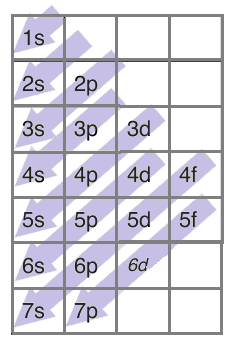
The electronic configuration of Cu is:
[A] $\left[ Ne \right]3{{s}^{2}}3{{p}^{6}}3{{d}^{9}}4{{s}^{2}}$
[B] $\left[ Ne \right]3{{s}^{2}}3{{p}^{6}}3{{d}^{10}}4{{s}^{1}}$
[C] $\left[ Ne \right]3{{s}^{2}}3{{p}^{6}}3{{d}^{3}}4{{s}^{2}}4{{p}^{6}}$
[D] $\left[ Ne \right]3{{s}^{2}}3{{p}^{6}}3{{d}^{5}}4{{s}^{2}}4{{p}^{4}}$
Answer
580.5k+ views
Hint: We know that the atomic number of copper is 29 and we can use it to write its electronic configuration. Copper will exist with a full-filled d-orbital, one electron from the last orbital will move to the inner 3d-orbital.
Complete answer: We know that the atomic number of copper is 29 and we can use it to write its electronic configuration. Copper will exist with a full-filled d-orbital, one electron from the last orbital will move to the inner 3d-orbital.

Now, following the above trend, the electronic configuration of copper should be $1{{s}^{2}}2{{s}^{2}}2{{p}^{6}}3{{s}^{2}}3{{p}^{6}}4{{s}^{2}}3{{d}^{9}}$.
But as we know, half-filled and full-filled d-orbitals gain extra stability therefore, one electron from the 4s-orbital moves to the 3d-orbitals and gains more stability. Therefore, the actual configuration of copper is $1{{s}^{2}}2{{s}^{2}}2{{p}^{6}}3{{s}^{2}}3{{p}^{6}}3{{d}^{10}}4{{s}^{1}}$
We can write the electronic configuration for any atom in terms of the nearest noble gas too. We can use argon for writing the configuration of copper but here, in the option we have neon so we will use that.
We know that the atomic number of neon is 10. Therefore, its electronic configuration will be$1{{s}^{2}}2{{s}^{2}}2{{p}^{6}}$. Therefore, in the electronic configuration of copper, in place of $1{{s}^{2}}2{{s}^{2}}2{{p}^{6}}$we can write [Ne].
Therefore, the electronic configuration of copper is $\left[ Ne \right]3{{s}^{2}}3{{p}^{6}}3{{d}^{10}}4{{s}^{1}}$.
So, the correct answer is “Option B”.
Note: Half-filled and full-filled p-orbitals and d-orbitals gain extra stability due to their symmetry. It is also due to the fact that this arrangement helps them gain higher stability due to higher exchange energy. Exchange energy is the energy which is released when two electrons with the same spin exchange their positions in the same energy orbital.
Complete answer: We know that the atomic number of copper is 29 and we can use it to write its electronic configuration. Copper will exist with a full-filled d-orbital, one electron from the last orbital will move to the inner 3d-orbital.

Now, following the above trend, the electronic configuration of copper should be $1{{s}^{2}}2{{s}^{2}}2{{p}^{6}}3{{s}^{2}}3{{p}^{6}}4{{s}^{2}}3{{d}^{9}}$.
But as we know, half-filled and full-filled d-orbitals gain extra stability therefore, one electron from the 4s-orbital moves to the 3d-orbitals and gains more stability. Therefore, the actual configuration of copper is $1{{s}^{2}}2{{s}^{2}}2{{p}^{6}}3{{s}^{2}}3{{p}^{6}}3{{d}^{10}}4{{s}^{1}}$
We can write the electronic configuration for any atom in terms of the nearest noble gas too. We can use argon for writing the configuration of copper but here, in the option we have neon so we will use that.
We know that the atomic number of neon is 10. Therefore, its electronic configuration will be$1{{s}^{2}}2{{s}^{2}}2{{p}^{6}}$. Therefore, in the electronic configuration of copper, in place of $1{{s}^{2}}2{{s}^{2}}2{{p}^{6}}$we can write [Ne].
Therefore, the electronic configuration of copper is $\left[ Ne \right]3{{s}^{2}}3{{p}^{6}}3{{d}^{10}}4{{s}^{1}}$.
So, the correct answer is “Option B”.
Note: Half-filled and full-filled p-orbitals and d-orbitals gain extra stability due to their symmetry. It is also due to the fact that this arrangement helps them gain higher stability due to higher exchange energy. Exchange energy is the energy which is released when two electrons with the same spin exchange their positions in the same energy orbital.
Recently Updated Pages
Why are manures considered better than fertilizers class 11 biology CBSE

Find the coordinates of the midpoint of the line segment class 11 maths CBSE

Distinguish between static friction limiting friction class 11 physics CBSE

The Chairman of the constituent Assembly was A Jawaharlal class 11 social science CBSE

The first National Commission on Labour NCL submitted class 11 social science CBSE

Number of all subshell of n + l 7 is A 4 B 5 C 6 D class 11 chemistry CBSE

Trending doubts
Differentiate between an exothermic and an endothermic class 11 chemistry CBSE

10 examples of friction in our daily life

One Metric ton is equal to kg A 10000 B 1000 C 100 class 11 physics CBSE

Difference Between Prokaryotic Cells and Eukaryotic Cells

1 Quintal is equal to a 110 kg b 10 kg c 100kg d 1000 class 11 physics CBSE

State the laws of reflection of light




